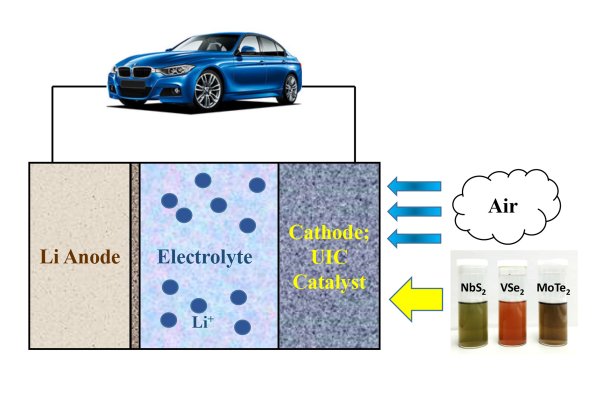Lithium-air batteries promise to be the next revolutionary alternative to the lithium-ion batteries currently used in electric cars, mobile phones and computers.
The lithium-air battery, which is still in the experimental stage of development, has 10 times the energy storage capacity of ordinary lithium-ion batteries and is much lighter. In other words, a lithium-air battery could be even more efficient and charge more efficiently if advanced catalysts are made from two-dimensional materials (materials in which electrons can move freely [flat] on a non-nanometer scale of just two dimensions [1-100nm]). Catalysts help increase the rate of chemical reactions within the battery, and depending on the type of material used, they can significantly improve the battery's ability to hold and provide energy.
Amin salehi-khojin, associate professor of mechanical and industrial engineering at the UICs school of engineering, said: "we will need very high energy densities to power new technologies used in mobile phones, laptops and especially electric cars." Salehi-khojin and his colleagues have synthesized several two-dimensional materials that can be used as catalysts. They found that some two-dimensional materials, when added as catalysts to an experimental lithium-air battery, gave the battery 10 times more energy than a lithium-air battery containing a traditional catalyst. Their findings appear in the journal advanced materials.
At the moment, electric cars average about 100 miles per charge, but if you add a two-dimensional material catalyst to a lithium-air battery, we can go nearly 400 to 500 miles per charge, which would be a real game changer, said salehi-khojin, the corresponding author of the paper. This would be a huge breakthrough in energy storage.
|
Salehi-Khojin和他的同事合成了15种不同类型的二维过渡金属双硫族化合物。TMDCs是一种独特的化合物,因为它具有很高的电子导电性和快速的电子转移能力,可以用来参与和其他材料的反应,例如在充电和放电时电池内部发生的反应。 研究人员在模拟锂空气电池的电化学系统中实验了15种TMDCs作为催化剂的性能。 UIC工程学院的研究生Leily Majidi是这篇论文的第一作者,他解释说,在二维结构下,TMDCs具有更好的电子性能和更大的反应表面积,可以在结构稳定的情况下参与电池内的电化学反应。 Majidi说,与金或铂等传统催化剂相比,这些材料的反应速度要快得多。 2D TMDCs表现如此出色的原因之一是,它们有助于加速锂空气电池的充放电反应。 Salehi-Khojin说,这就是所谓的催化剂的双功能。 二维材料还能与电解质协同作用,电解质是离子在充电和放电过程中通过的材料。 我们使用的2D TDMCs和离子液体电解质作为一个辅助催化剂系统,帮助电子更快地转移,导致了更快的电荷转移、更有效的储存和释放能量。 Salehi-Khojin说:“这些新材料代表了一种新的途径,可以将电池提升到一个新的水平。我们只需要找到方法,在更大的规模上更有效地生产和调整电池。” 芝加哥伊利诺伊大学的Poya Yasaei、Zahra Hemmat、Pedram Abbasi、Shadi Fuladi、Xuan Hu、Robert Klie、Fatemeh Khalili-Araghi和Baharak Sayahpour以及普渡大学的Robert Warburton和Jeffrey Greeley是这篇论文的共同作者。 这项研究得到了国家科学基金会DMREF基金1729420的部分支持。 (原文来自:每日科学 中国新能源网综合) |
Previous:Already the first article


